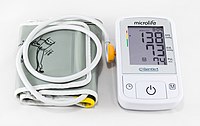
Photo from wikipedia
Endotracheal tube (ETT) cuff hyperinflation is known to cause ischaemia of tracheal mucosa, postoperative sore throat and many other complications [1, 2]. The recommended ETT cuff pressure is between 20… Click to show full abstract
Endotracheal tube (ETT) cuff hyperinflation is known to cause ischaemia of tracheal mucosa, postoperative sore throat and many other complications [1, 2]. The recommended ETT cuff pressure is between 20 and 30 cm of water [3]. ETT cuff is usually either not measured at all or measured intermittently using analogue/digital cuff manometers. Continuous measurement of ETT cuff pressure has been recommended [4]. Subjective measurement of cuff pressure like palpation of pilot balloon has been proven to be inaccurate. A simple method of identifying overinflation of ETT cuff is described here. A 1 l normal saline intravenous fluid bag (Freeflex bag; Fresenius Kabi, USA) is hanged on an intravenous fluid stand and the upper end of the bag is cut so as to expose it to atmospheric pressure (Fig. 1). Through the injection port on the other end of the saline bag, an 18-G needle is inserted. The needle is connected to a 3-way tap connector (BD ConnectaTM, Becton Dickinson Infusion Therapy Systems, Mexico). To one of the ends of this 3-way connector, male fitting connector (the plastic part which connects to an iv cannula) of an blood administration set (Umaflow; Royal Surgicare, Gujarat, India) is connected. Alternatively, a male to male connector can also be used in place of the male fitting connector. To identify hyperinflation of the ETT cuff, the pilot balloon of the ETT is connected to the free end of the male plastic connector (either directly or through an air filled high pressure tubing of appropriate length. The vertical height of 1 l Freeflex bag is 31.5 cm and it tilts to one side slightly upon cutting the upper end, so that the vertical height of this column of fluid exerts a hydrostatic pressure of approximately 25–27 cm (black line in Fig. 1). If the ETT cuff is hyperinflated, the excess air will leave the cuff and appear as bubbles rising through the normal saline bag. This will keep on occurring till the ETT cuff pressure equalises to around 25–27 cm. We tested this method in a bench study taking a total of 20 readings. We directly measured the cuff pressure of an adult ETT size 8.0 mm internal diameter with a pressure transducer (EdwardsTM; USA) to confirm that this method indeed resulted in a cuff pressure of 25–27 cm (± 2 cm) of water. This method thus may be used as a rough estimate to prevent hyperinflation of ETT cuff in resource constrained situations. The principles used in this method should be further refined and investigated before universal use.
Journal Title: Journal of Clinical Monitoring and Computing
Year Published: 2020
Link to full text (if available)
Share on Social Media: Sign Up to like & get
recommendations!